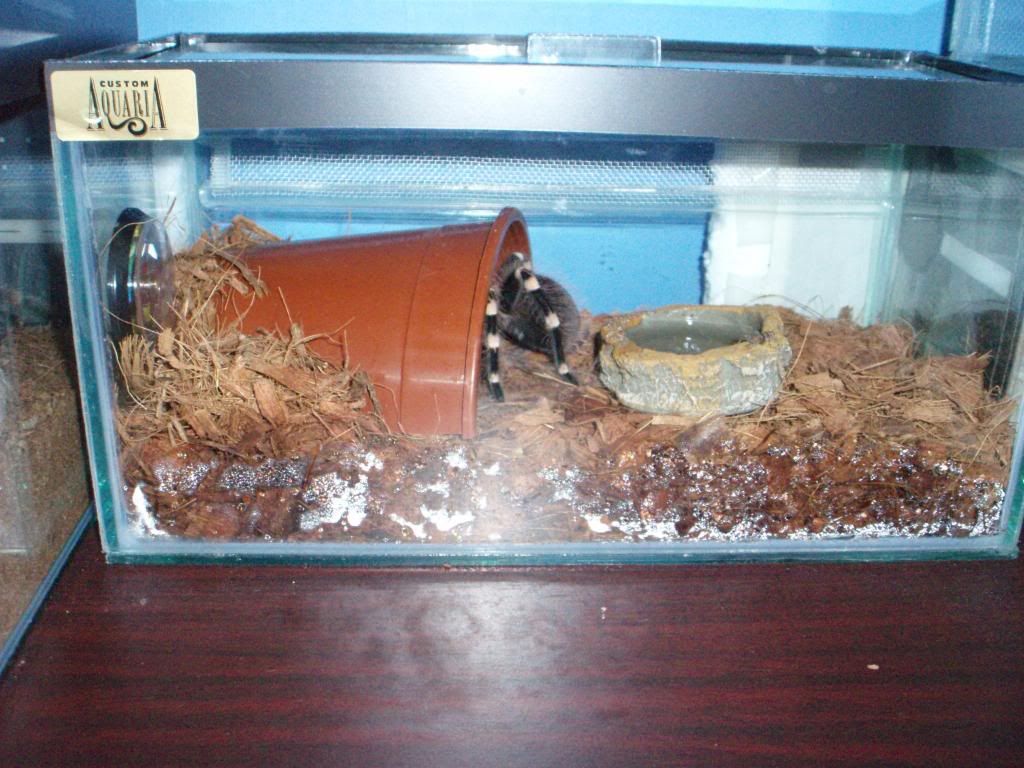Sorry to bother you guys, but I am really at a bit of a loss here.
I have a sub-adult B.smithi and 6 tiny, assorted South American slings (Brachyplemas and Grammostolas)
The smithi is in the medium, low, Exo-terra faunarium with a heat mat covering half the back wall. She tends to spend all her time by the heatmat.
The babies are in delipots in another exact same faunarium but with a bigger heat mat covering the full back wall.
I was worrying because my house gets cold during the night, I can't afford to keep the heating on all night. I have been getting up to the digital thermometers in the tanks being around 15 degrees in the past week. And this is not as cold as January, by any means During the day the thermometers vary from 20-22 degrees. This is with the heating on so I am comfortable, any hotter in here and I would feel ill.
During the day the thermometers vary from 20-22 degrees. This is with the heating on so I am comfortable, any hotter in here and I would feel ill.
So, following advice from various tarantula owners, I bought a Viv-exotic LX36 vivarium and popped both tanks in that. The idea being that the heatmats will be more efficient now inside a wooden box. So I had a happy afternoon assembling that and putting the tanks and cabling in.
I don't yet know if it will keep the tanks warmer (it better!), but I have discovered a bit of a side-effect that I never thought of.
I can only just see the spiders through the glass doors. Right now I have the normal room lighting turned on and can see the spiders, but not clearly. I don't know if it will be better in daylight, the vivarium is on the wall between the two windows, so I doubt it.
Can I light the vivarium in some way, so I can see my lovely tarantulas? I know they don't like bright lights, and am aware that it can dessicate them, so obviously don't want to glare them out. But I do want to see them!
I would be very grateful for any advice on this. I am a fretter and it seems the more I do to try to make things perfect for my fuzzy friends, the more issues I find, heh.
I have a sub-adult B.smithi and 6 tiny, assorted South American slings (Brachyplemas and Grammostolas)
The smithi is in the medium, low, Exo-terra faunarium with a heat mat covering half the back wall. She tends to spend all her time by the heatmat.
The babies are in delipots in another exact same faunarium but with a bigger heat mat covering the full back wall.
I was worrying because my house gets cold during the night, I can't afford to keep the heating on all night. I have been getting up to the digital thermometers in the tanks being around 15 degrees in the past week. And this is not as cold as January, by any means
So, following advice from various tarantula owners, I bought a Viv-exotic LX36 vivarium and popped both tanks in that. The idea being that the heatmats will be more efficient now inside a wooden box. So I had a happy afternoon assembling that and putting the tanks and cabling in.
I don't yet know if it will keep the tanks warmer (it better!), but I have discovered a bit of a side-effect that I never thought of.
I can only just see the spiders through the glass doors. Right now I have the normal room lighting turned on and can see the spiders, but not clearly. I don't know if it will be better in daylight, the vivarium is on the wall between the two windows, so I doubt it.
Can I light the vivarium in some way, so I can see my lovely tarantulas? I know they don't like bright lights, and am aware that it can dessicate them, so obviously don't want to glare them out. But I do want to see them!
I would be very grateful for any advice on this. I am a fretter and it seems the more I do to try to make things perfect for my fuzzy friends, the more issues I find, heh.


 [/IMG]
[/IMG]
Comment